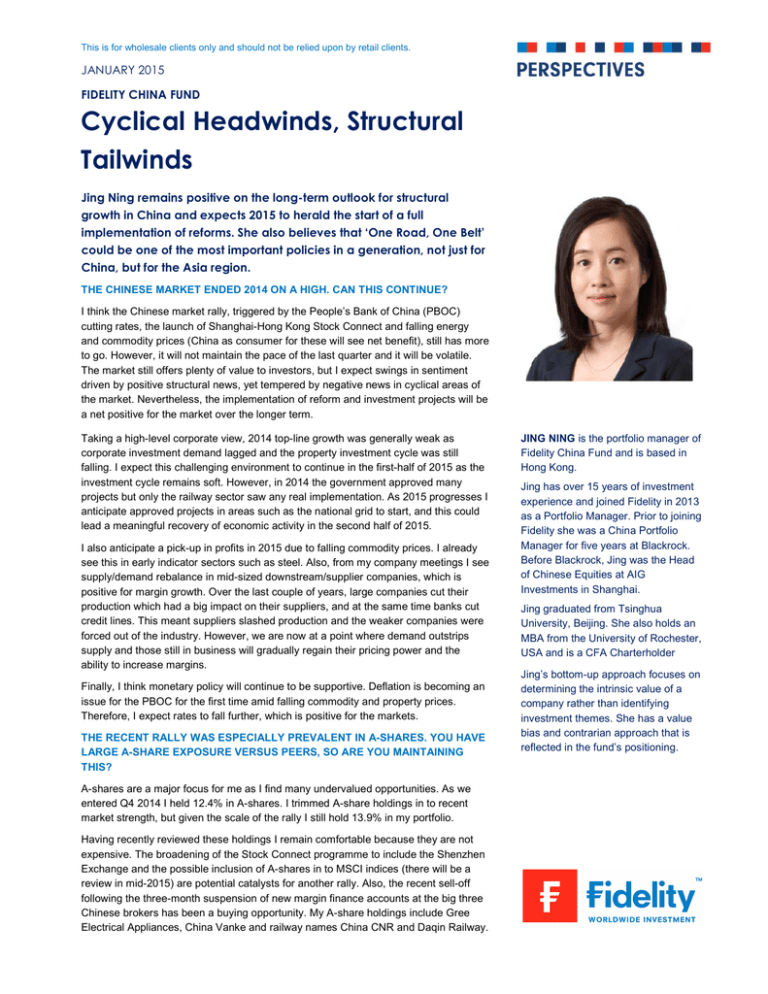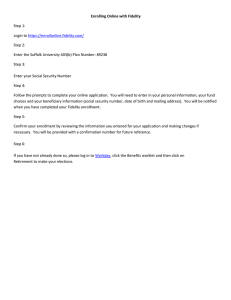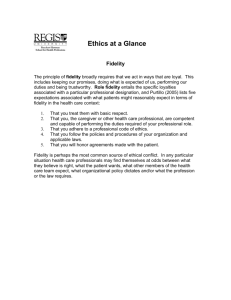China Fund Perspective- Jan 2015
advertisement

This is for wholesale clients only and should not be relied upon by retail clients. JANUARY 2015 FIDELITY CHINA FUND Cyclical Headwinds, Structural Tailwinds Jing Ning remains positive on the long-term outlook for structural growth in China and expects 2015 to herald the start of a full implementation of reforms. She also believes that ‘One Road, One Belt’ could be one of the most important policies in a generation, not just for China, but for the Asia region. THE CHINESE MARKET ENDED 2014 ON A HIGH. CAN THIS CONTINUE? I think the Chinese market rally, triggered by the People’s Bank of China (PBOC) cutting rates, the launch of Shanghai-Hong Kong Stock Connect and falling energy and commodity prices (China as consumer for these will see net benefit), still has more to go. However, it will not maintain the pace of the last quarter and it will be volatile. The market still offers plenty of value to investors, but I expect swings in sentiment driven by positive structural news, yet tempered by negative news in cyclical areas of the market. Nevertheless, the implementation of reform and investment projects will be a net positive for the market over the longer term. Taking a high-level corporate view, 2014 top-line growth was generally weak as corporate investment demand lagged and the property investment cycle was still falling. I expect this challenging environment to continue in the first-half of 2015 as the investment cycle remains soft. However, in 2014 the government approved many projects but only the railway sector saw any real implementation. As 2015 progresses I anticipate approved projects in areas such as the national grid to start, and this could lead a meaningful recovery of economic activity in the second half of 2015. I also anticipate a pick-up in profits in 2015 due to falling commodity prices. I already see this in early indicator sectors such as steel. Also, from my company meetings I see supply/demand rebalance in mid-sized downstream/supplier companies, which is positive for margin growth. Over the last couple of years, large companies cut their production which had a big impact on their suppliers, and at the same time banks cut credit lines. This meant suppliers slashed production and the weaker companies were forced out of the industry. However, we are now at a point where demand outstrips supply and those still in business will gradually regain their pricing power and the ability to increase margins. Finally, I think monetary policy will continue to be supportive. Deflation is becoming an issue for the PBOC for the first time amid falling commodity and property prices. Therefore, I expect rates to fall further, which is positive for the markets. THE RECENT RALLY WAS ESPECIALLY PREVALENT IN A-SHARES. YOU HAVE LARGE A-SHARE EXPOSURE VERSUS PEERS, SO ARE YOU MAINTAINING THIS? A-shares are a major focus for me as I find many undervalued opportunities. As we entered Q4 2014 I held 12.4% in A-shares. I trimmed A-share holdings in to recent market strength, but given the scale of the rally I still hold 13.9% in my portfolio. Having recently reviewed these holdings I remain comfortable because they are not expensive. The broadening of the Stock Connect programme to include the Shenzhen Exchange and the possible inclusion of A-shares in to MSCI indices (there will be a review in mid-2015) are potential catalysts for another rally. Also, the recent sell-off following the three-month suspension of new margin finance accounts at the big three Chinese brokers has been a buying opportunity. My A-share holdings include Gree Electrical Appliances, China Vanke and railway names China CNR and Daqin Railway. JING NING is the portfolio manager of Fidelity China Fund and is based in Hong Kong. Jing has over 15 years of investment experience and joined Fidelity in 2013 as a Portfolio Manager. Prior to joining Fidelity she was a China Portfolio Manager for five years at Blackrock. Before Blackrock, Jing was the Head of Chinese Equities at AIG Investments in Shanghai. Jing graduated from Tsinghua University, Beijing. She also holds an MBA from the University of Rochester, USA and is a CFA Charterholder Jing’s bottom-up approach focuses on determining the intrinsic value of a company rather than identifying investment themes. She has a value bias and contrarian approach that is reflected in the fund’s positioning. WHAT ARE THE CYCLICAL HEADWINDS INVESTORS SHOULD BE AWARE OF? There are cyclical issues that are weighing on market sentiment. The most prominent of these are falling property prices, oversupply in heavy industrial products (cement, paper, etc), slowing consumption and the restructuring of LGIV. Each is a risk, but manageable. Property prices have been falling but underlying demand is still there. Urbanisation is still a main focus for China’s leadership, and this is providing price support as oversupply is bought as prices drop. This means inventory is being run down and we are getting closer to a new property investment cycle. Oversupply of heavy industrial goods is something that needs to be addressed and I would like to see the most inefficient producers be allowed to go out of business. Slowing consumption must also be monitored, but the government is still committed to shifting to a consumption-led economic model and it will continue to implement favourable consumption policies. However, such policies will likely focus on massconsumption rather than luxury given the anti-corruption campaign. Central government is also determined to clean up the local government debt situation and provincial governments are now in the process of restructuring LGIVs. There may be risk of some local government defaults in 2015. WHAT ARE THE STRUCTURAL TAILWINDS? 2015 is the third year of the current government’s reign and I think it will be characterised by the implementation of reform. In Xi Jinping’s first year in charge he excited the markets by announcing a high level vision for reform, including changing the hukou system and one child policy. His second year has been dominated by an anti-corruption rhetoric, which despite acting as a form of austerity, has enabled the government to build a general consensus on reform. Now the right people are in place and high level changes have broadly been accepted, 2015 should see the start of real implementation. This will take many different forms, but fiscal and monetary policy, SOE and rural land reform will probably be the most significant stories for 2015. To give examples, we have just seen: the government introduce a pilot programme in Shenzhen that allows power companies to sell direct to consumers and have more control over their tariff; the National Development and Reform Commission (NDRC) issued a statement on the liberalisation of drug pricing; and the NDRC is starting to allow prices in railway rolling stock and freight cargo to freely float. The government is trialing such reforms in different cities and regions in order to understand their impact and tweak policy before incrementally rolling these out across the country. Because these are small steps they do not generate attention grabbing headlines, hence it is often missed by investors. However, when taken in aggregate and assessing the impact this could have on the economy over the next few years, I strongly believe that the foundations for companies to grow is attractive and underappreciated. WHAT ABOUT ‘ONE ROAD, ONE BELT’? ‘One Road, One Belt’ could be one of the most important policies in a generation, not just for China, but for the region. Essentially, its aim is to re-establish the ancient land and maritime trade routes (e.g. Silk Road) in the Eurasian continent, with China at the hub. Apart from China physically being at the centre, the aim will be to ingrain its companies, products and monetary power within the region. It is a concept of exporting expertise and RMB, and in recent meetings with companies across many industries ‘One Road, One Belt’ is a buzz phrase. The most obvious manifestation is that China will help build infrastructure across Eurasia (and possibly in to Africa), and financially support these projects by offering RMB loans, which lessens the importance of US dollars. China can then use these routes to export goods and offer linked services. For example, I met a pharmaceutical company in Shenzhen and they are already investigating how to tap new markets on the back of this. The caveat is that we are currently light on detail as to how this will work, but there is strong support from the government. From an investment perspective, areas like railway manufacturers could be long-term winners. However, because this is early days I think of ‘One Road, One Belt’ as a call option for some of my construction and infrastructure holdings. HOW DO YOU POSITION YOUR PORTFOLIO UNDER THE CURRENT MARKET CONDITIONS? I take a value approach and look for high quality business models and management teams that are out of favour due to short-term macroeconomic or company-specific reasons. As a result, I hold a significant overweight in mass-consumer names as the anti-corruption measures have indiscriminately impacted in the entire consumer sector. I have also been adding to consumer staples. As mentioned above, I still find value in A-shares and see general demand for this market growing. I am neutral financials, but there is a clear distinction of being underweight banks and overweight real estate and insurance. Banks still have NPL issues that need to be addressed, but the insurance sector remains underpenetrated and will see more policy support. IT remains a large underweight as I think valuations price in a blue sky scenario, yet many of these businesses models are untested. Meanwhile, I favour stocks that I think can benefit from the implementation of reform, such as railway companies. This document is issued by FIL Responsible Entity (Australia) Limited ABN 33 148 059 009, AFSL No. 409340 (“Fidelity Australia”). Fidelity Australia is a member of the FIL Limited group of companies commonly known as Fidelity Worldwide Investment. Prior to making an investment decision retail investors should seek advice from their financial adviser. Please remember past performance is not a guide to the future. You should consider the Product Disclosure Statements (“PDS”) for Fidelity Australia products before making a decision whether to acquire or hold the product. Investors should also obtain and consider the Product Disclosure Statement (“PDS”) for the fund mentioned. The relevant PDS can be obtained by contacting Fidelity Australia on 1800 119 270 or by downloading it from our website at www.fidelity.com.au. This webcast or podcast has been prepared without taking into account your objectives, financial situation or needs. You should consider such matters before acting on the information contained in this webpage including any linked webcasts or podcasts. This webcast or podcast may include general commentary on market activity, industry or sector trends or other broad based economic or political conditions which should not be construed as investment advice. Information stated herein about specific securities is subject to change. Any reference to specific securities should not be construed as a recommendation to buy, sell or hold these securities. While the information contained in this webcast or podcast has been prepared with reasonable care, no responsibility or liability is accepted for any errors or omissions or misstatements however caused. References to ($) are in Australian dollars unless stated otherwise. Investments in overseas markets can be affected by currency exchange and this may affect the value of your investment. Investments in small and emerging markets can be more volatile than other more developed markets. Fund references are correct at time of first publication but are subject to change and may not represent actual holdings in the fund at the time of this viewing. The webcast or podcast may not be reproduced or transmitted without prior written permission of Fidelity Australia. The issuer of Fidelity’s funds is FIL Responsible Entity (Australia) Limited ABN 33 148 059 009, AFSL No. 409340 (“Fidelity Australia”). © 2015 FIL Responsible Entity (Australia) Limited. Fidelity, Fidelity Worldwide Investment, and the Fidelity Worldwide Investment logo and F symbol, are trademarks of FIL Limited.



